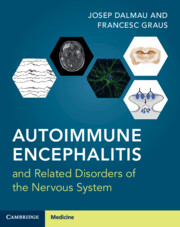Book contents
- Autoimmune Encephalitis and Related Disorders of the Nervous System
- Autoimmune Encephalitis and Related Disorders of the Nervous System
- Copyright page
- Dedication
- Contents
- Clinical Vignettes
- Videos
- Preface
- Abbreviations
- Section 1 Overview
- Chapter 1 Importance, Definitions, History, Classification, and Frequency of the Autoimmune Encephalitides
- Chapter 2 General Approach to Diagnosis
- Chapter 3 Pathogenesis and Disease Mechanisms in Neuronal Antibody-Mediated Encephalitis
- Section 2 Antibodies and Antigens
- Section 3 Specific Syndromes and Diseases
- Section 4 Autoimmunity in Neurological and Psychiatric Diseases
- Index
- References
Chapter 2 - General Approach to Diagnosis
from Section 1 - Overview
Published online by Cambridge University Press: 27 January 2022
- Autoimmune Encephalitis and Related Disorders of the Nervous System
- Autoimmune Encephalitis and Related Disorders of the Nervous System
- Copyright page
- Dedication
- Contents
- Clinical Vignettes
- Videos
- Preface
- Abbreviations
- Section 1 Overview
- Chapter 1 Importance, Definitions, History, Classification, and Frequency of the Autoimmune Encephalitides
- Chapter 2 General Approach to Diagnosis
- Chapter 3 Pathogenesis and Disease Mechanisms in Neuronal Antibody-Mediated Encephalitis
- Section 2 Antibodies and Antigens
- Section 3 Specific Syndromes and Diseases
- Section 4 Autoimmunity in Neurological and Psychiatric Diseases
- Index
- References
Summary
The diagnosis of autoimmune encephalitis should be considered in patients with rapid progression (<3 months) of short-term memory loss, decreased or altered level of consciousness, lethargy, personality change, or psychiatric manifestations in association with at least one of the following criteria: new-onset seizures or focal CNS symptoms, CSF pleocytosis, or MRI features suggestive of brain inflammation. Many alternative causes of encephalitis can be excluded after a careful clinical history and evaluation of the CSF, brain MRI, and routine blood tests. Some types of encephalitis can be suspected before receiving the results of neural antibodies, according to the clinical presentation (for instance, faciobrachial dystonic seizures in anti-LGI encephalitis, or psychotic manifestation in anti-NMDAR encephalitis) or brain MRI features (temporal lobe involvement in limbic encephalitis). Antibody testing may show false positive and negative results, particularly when only serum is examined, results are not confirmed with additional laboratory studies, or the test is used indiscriminately without selection of patients.
Keywords
- Type
- Chapter
- Information
- Publisher: Cambridge University PressPrint publication year: 2022



